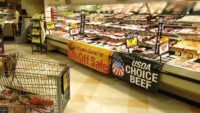Case-ready continues its upward climb across proteins, now representing 83% of packages, according to findings unveiled in the 2022 CRYOVAC brand National Meat Case Study (NMCS). The study, which has been sponsored by SEE and its CRYOVAC brand since 2002, shows a steady upward trend for case-ready fresh meat, growing from 49% in 2002, to 81% in 2018 and now enjoying an 83% share of packages in 2022.
“This really gels with the fact that more and more retailers are switching to case-ready, and that number continues to grow,” said Stacey Couch, marketing development director retail & e-commerce at Sealed Air. “The 2022 study also shows that a lot more retailers are taking options to go to some of the more sustainable packages, more rigid trays, less foam, and less in store overwrap with foam.”
While case-ready numbers are rapidly growing, the number of fresh meat SKUs are declining, perhaps due to ongoing supply chain issues, says Couch. The study indicates the number of fresh meat SKUs are 10% lower than reported in 2018, dropping from an average of 130 in stores in 2018 to 117 in stores in 2022.
Reflecting current market conditions, chicken SKUs and packages are down, while beef and ground beef are up. The number of packages remain the same with an average of 1,039 per store.
Meat rules the perimeter as consumers and retailers embrace the convenience of case-ready
Meat sales exploded in 2020 and dollar growth continues while units and volume remain ahead of 2019 pre-pandemic levels. Meat is holding its position as king of the perimeter, with $85.5 billion in sales in 2022, 6.5% ahead of 2021 figures, according to IRI research.
Additionally, according to the 2021 Power of Meat report, 81% of consumers say they think case-ready meats are equally as good—if not better—than meats cut and packaged in the store.
As consumer trust and acceptance of case-ready has risen, the 2022 National Meat Case Study shows that case-ready is now the norm across all proteins, led by turkey (99%) and chicken (96%). Beef is the most likely to be cut in store, though case-ready has increased to 71% of packages from 66% in 2018.
“For this study, we define case-ready as anything that has an establishment number on it,” explains Couch. “If it was made in store, it doesn’t have an establishment number on it, and if it was made at the processor, it will have an establishment number.
“When we started this study in 2002, 51% of product was being cut and packaged at the store level. Those number have completely flipped and now only 17% is being cut and packaged in store. Now, 83% of everything you see in store is processed and packaged away from the store. That number has steadily risen year over year, and we believe it will continue to climb,” Couch added.
As labor woes continue, case-ready is on the rise
Additionally, case-ready provides a solution for grocery retailers who continue to face the challenge of hiring skilled butchers. Case-ready helps retailers maintain the high level of quality product consumers expect while also allowing grocers to keep the meat case stocked with a variety of meats and cuts for their consumers.
2022 also brings a reversal to the rise of boneless, likely directly related to ongoing labor shortages. Since 2018, boneless beef packages dropped from 92% to 87%, pork from 69% to 64% and chicken from 61% to 56%.
The overall share of eligible packages that are boneless had been consistently increasing over the years from 57% in 2002 to 72% in 2018. But in the 2022 study, boneless dropped down to 67%. Meats such as grinds or cubed steak that are always boneless are not included in these figures.
“Across the board, beef, pork and chicken all declined in the number of boneless packages and most of that we believe it driven by the labor woes that a lot of the processors were having, so they didn’t have the labor to bone out some of that product,” said Couch.
The average package weight remained fairly stable, with small increases for chicken, pork, beef and turkey — directly related to a greater bone-in share versus 2018.
E-commerce and ease of use drives demand for vacuum packaging
Consumer acceptance for online grocery shopping, as well as an interest in convenience and the desire to keep food fresher longer, has grown the demand for vacuum packaging. This case-ready solution now leads the way in the type of packaging found in-store due to its leakproof capabilities and ease of use.
In addition, case-ready vacuum solutions offer a wide range of distribution and storage flexibility from retail fresh to e-commerce fresh or frozen, which enables use of one package format for multiple applications.
“What makes this really interesting is the impressive upward trend of vacuum versus the downward trend of PVC wrap, the type of packaging wrap typically used at store level,” said Couch. “When we first started this survey, 51% of packages at store level were packaged with PVC wrap, while only 9% were vacuum packed. Now, vacuum packaging leads all packaging types at 32% while PVC wrap has dropped almost by half to 28%.”
Vacuum packages include those that use rollstock, including saddle packs, as well as shrink bags and vacuum skin, various options that make it easier for consumers to prepare and store meat products.
In a nod to growing interest in sustainable options, the NMCS shows increasing use of trayless packages (including semi-rigid) while foam trays are on the decline. Trayless now represents 41% of packages, up from 33% in 2018, while foam is now at 39%, down from 53% in 2018.
“Change seems to be happening faster than ever before and this year’s National Meat Case Study is a great tool to gauge what consumers see when they enter the stores and how various packaging options can address the needs of both retailers and consumers,” said Couch.
Methodology
The 2022 National Meat Case Study was conducted between February and May of 2022. SEE field experts and Texas Tech students documented the meat case inventory across a market reflection of traditional supermarkets, clubs, supercenters and specialty stores. The study reflects research conducted at 152 stores in 97 U.S. cities, including a sample of 180,000 packages and 20,500 SKUs. Conducted for the first time in 2002, 2022 marks the eighth edition of the study that tracks trends in the meat case.
Source: Sealed Air



